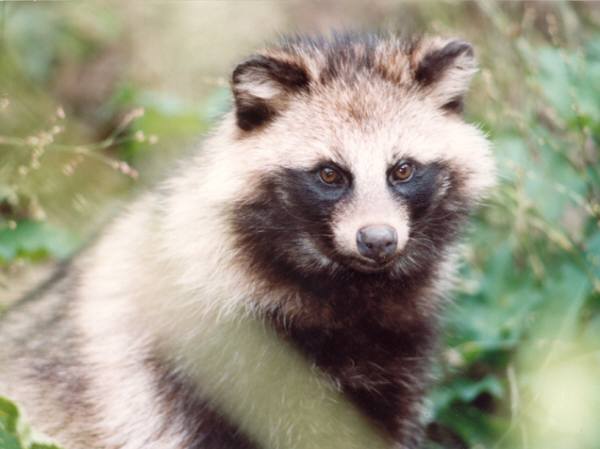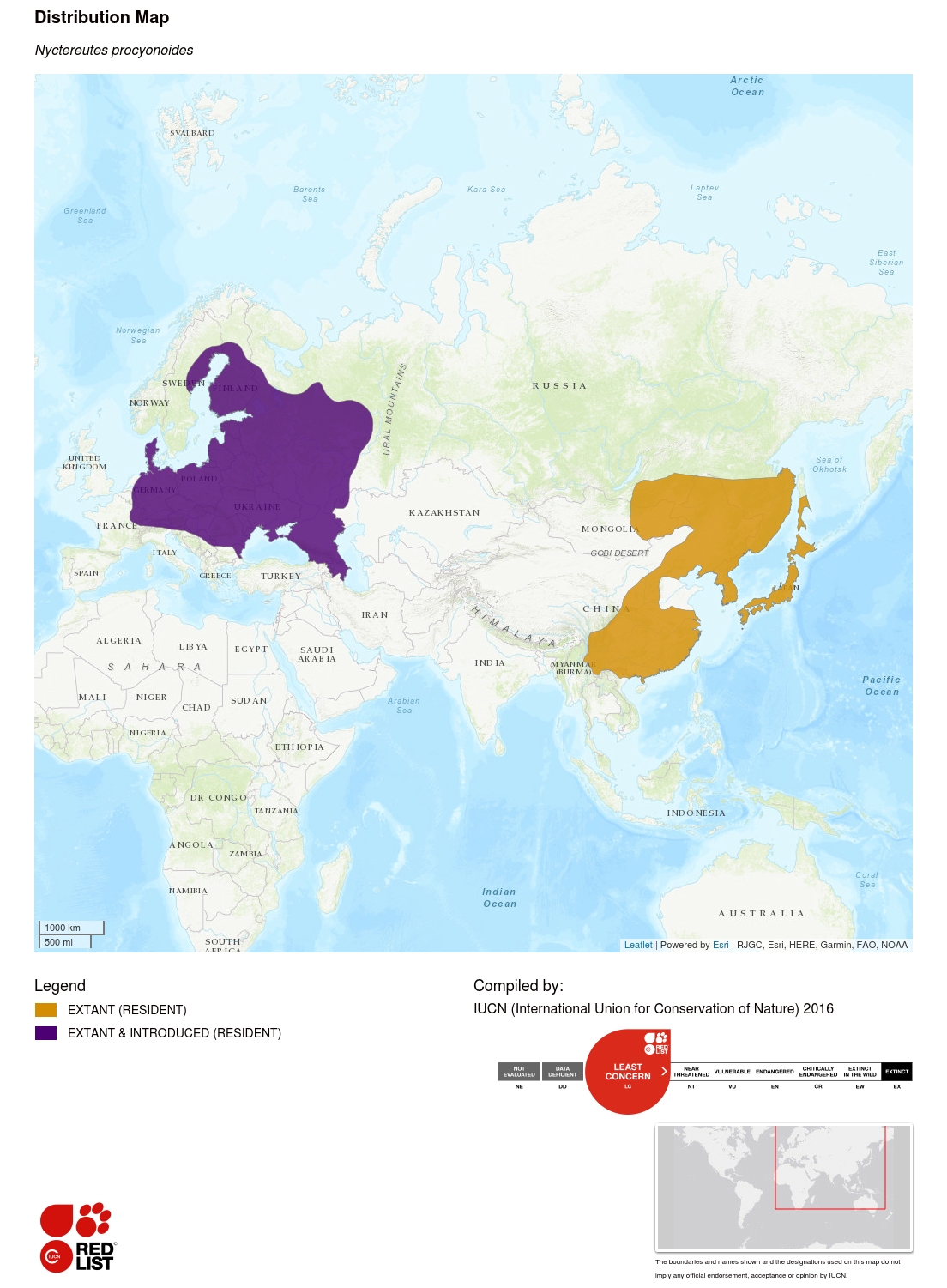
- South America
- Central & North America
- Europe & North/Central Asia
- Sub-Saharan Africa
- North Africa & the Middle East
- South Asia
Europe & North/Central AsiaRaccoon dog Nyctereutes procyonoides

raccoon dog - © Tanuki Club
Relevant LinksReports / PapersOther NamesEnglish: Raccoon Dog
French: Chien viverrin
Spanish; Castilian: Perro Mapache
Chinese: Háo zi
Croatian: Kunopas
Danish: Mårhund
Estonian: Kährikoer
Finnish: Supikoira
German: Marderhund
Indonesian: Tjerpelai
Italian: Cane Procione
Japanese: Tanuki
Korean: Nurgoori
Norwegian: Mårhund
Polish: Jenot
Portuguese: Câo-mapache
Romanian: Câinele Enot
Russian: Enotovidnaya Sobaka
Swedish: Mårdhund

Taxonomic Notes
There are six recognized subspecies: albus, koreensis, orestes, procyonoides, ussuriensis and viverrinus. It has been suggested recently that Japanese Raccoon Dogs should be classified as a distinct species Nyctereutes viverrinus with two subspecies N. v. viverrinus and N. v. albus (Sang-In et al. 2015). The classification is based on chromosomal, molecular and morphological differences between Japanese and mainland populations (see also Kauhala and Saeki 2004a).
Justification
The Raccoon Dog has been widely introduced outside of its historic native range, and is now widespread, and common, in northern, central and eastern Europe, and is still spreading towards the west and south (Kauhala and Kowalczyk 2011). It is also common in its native range in East Asian countries. Although subject to some possible localized declines, there is no evidence to suggest that the species is at any risk of extinction, and is listed as Least Concern.
Geographic Range Information
The native range of this species extends from northern Indochina (ranging as far south as north-eastern Viet Nam, east of the Red River, and southern Yunnan province in China) through the eastern provinces of China and the Korean Peninsula to the south-east corner of Russia and Mongolia. In the Japanese Archipelago, the species is present throughout Hokkaido, Honshu, Shikoku, Kyushu, Awaji island, Sado island and other islets of Japan except those south of Kyushu (e.g., Okinawa islands, Nansei islands, Miyako islands and Ogasawara islands). Introduced to Yakushima island (S. Azuma, in Kauhala and Saeki 2004b). Absent from Hainan and Taiwan, Province of China.
The species was introduced in the early to mid-part of the 20th Century to European parts of the former Soviet Union and since then the species has become widespread in northern and eastern Europe, thriving in a landscape which is a mosaic of moist forests with abundant undergrowth, damp meadows and gardens (Kauhala et al. 2010). The northern limit of distribution lies in areas where the mean temperature of the year is just above 0°C, the snow cover <800 mm, the duration of the snow cover <175 days and the length of the growing season >135 days (for example, in Finland the northern limit of permanent distribution is between 65°N and the Arctic Circle). In recent years, when winters have become milder, the Raccoon Dog has expanded its range northwards (in Finland, up to 67°N). Raccoon Dogs appear to have been expanding their range in recent times, including a record in 2002 from the central part of the Former Yugoslav Republic of Macedonia (at the time the southernmost point of its European range; ?irovi? 2006) and a road-kill in south-eastern Spain in 2008 (Kauhala and Kowalczyk 2011). The latter authors provide a detailed review of the history of colonization of the Raccoon Dog in Europe.
Population trend:Stable

Population Information
Outside of Japan, where the species is common, there is no information on abundance in their native range. Lau et al. (2010) noted that in China they probably still exist in the wild in parts of Guangxi and Guangdong, but are otherwise likely to be threatened. Population estimates have never been conducted in Japan, but indirect indices (e.g., road-kills per km of the National Express-ways and harvest density per prefecture), suggest that relative abundance is high in south-western parts of Japan (i.e., Kyushu, Shikoku, and Chugoku) and low in Hokkaido, Chubu, and extremely urban areas (Kauhala and Saeki 2004b; and see Table 5.4.2 therein). In Viet Nam, the southerly extent of their range, there is very little information available on their status. A survey undertaken in 2004 in five areas in Na Hang District, Tuyen Quang Province, recorded two captive young animals in Na Vang village after apparently having been taken from a small cave (presumably a den) in Lung Nhoi area (Le Trong Trai et al. 2004), but there is otherwise no other recent information.
The species is common in the introduced range; for example, in Finland the adult population consists of 110,000-120,000 individuals (hunting bag 160,000-170,000 individuals each year). The autumn population, including the young of the year would be about 320,000.
Habitat and Ecology Information
Two features are typical of the habitat of Raccoon Dogs: 1) they are often found near water; and 2) during autumn they are more or less dependent on fruits and berries, which affect their habitat selection. In Japan, their habitat includes deciduous forests, broad-leaved evergreen forests, mixed forests, farmlands, and urban areas from coastal to subalpine zones. In the countryside, the species prefers herbaceous habitat and uses less Cryptomeria plantation throughout year, while riparian areas are often used (Kauhala and Saeki 2004b). In urban areas, Raccoon Dogs inhabit areas with as little as 5% forest cover (Yamamoto et al. 1995). In the Russian Far East, the Raccoon Dog favours open landscape, especially damp meadows and agricultural land and avoids dark forests (Judin 1977).
In the introduced range, Raccoon Dogs favour moist meadows and other habitats with abundant undergrowth, mixed forests and shores of rivers and lakes, especially in early summer (Korneev 1954, Nasimovic and Isakov 1985, Kauhala 1996). In late summer and autumn, they favour moist heaths with abundant berries (Morozov 1947, Kauhala 1996). However, in the Finnish archipelago, they live in barren pine forests where they feed on crowberries (Empetrum nigrum) (Kauhala and Auniola 2000). In Finland, generally the best landscape for Raccoon Dogs is a landscape with abundant undergrowth, a mosaic of moist forests, damp meadows, gardens and agricultural area (Kauhala and Auttila 2010, Kauhala et al. 2010). The population is sparse in large coniferous forests.
Threats Information
Raccoon Dogs are still persecuted across much of their native range as a pest species. They also may be affected locally by predation from feral dogs, road kills, and from epidemics (including scabies and canine distemper virus), and in some cases may be declining due to extreme habitat loss. The Raccoon Dog is an important vector and victim of rabies in Europe, with increasing significance towards the east and north.
Use and Trade Information
The Russians introduced Raccoon Dogs into the wild in the European part of the former Soviet Union because they wanted to establish a valuable new fur animal in the wild. Raccoon Dog furs continue to be commercially sold, although today they are produced in fur farms. While the species is still commonly farmed for fur in Finland (albeit less intensively than 20-30 years ago), Raccoon Dogs are no longer farmed in Sweden or Hungary, where the last fur farm was closed in 1995. In Japan, Raccoon Dog fur is also used in the production of calligraphic brushes, stuffed animals, and other products. Today, Raccoon Dogs are mainly hunted because they are considered pests. In Japan, legal culling increased from the 1970s to 15,176 animals in 2012. However, the numbers harvested has declined from a peak of 76,000 in 1981. In China, about 15 million Raccoon Dogs were held by fur farmers in 2010, and China is the largest producer and exporter of Raccoon Dog fur in the world (Petry and Liting 2010). In Finland, the yearly hunting bag for 2013 was about 160,000 animals (Finnish Game and Fisheries Research Institute 2014). In Poland, where Raccoon Dogs are hunted from August to March, the annual bag was 450–600 in the early 1990s, but more than 11,000 are now hunted annually (Kauhala and Kowalczyk 2011). In Germany, 30,000 Raccoon Dogs were hunted in the hunting season of 2008/2009 (Anon., in Kauhala and Kowalczyk 2011).
Conservation Actions Information
Legislation
Not listed in the CITES Appendices.
In many countries in the introduced part of their range, where the Raccoon Dog is legally hunted, hunting is permitted year round (e.g., Sweden, Hungary). However, in Finland, females with pups are protected in May, June and July, and in Belarus hunting is allowed from 1 October to the end of February. In Japan, hunting/trapping of the species requires a licence or other form of permission and can only occur within the designated hunting season (November 15 to February 15). The Raccoon Dog on Mukojima island (18.4 km²), Hiroshima prefecture, is designated as a natural monument under the Law for the Protection of Cultural Properties, and permission from the Director-General of the Agency of Cultural Affairs is required for capturing the animals on the island.
Presence in protected areas
Raccoon Dogs occur in national parks and other wildlife protection areas in Japan, where hunting and some other activities are prohibited. Elsewhere across their range, they occur in numerous protected areas and wildlife sanctuaries.
Presence in captivity
In Japan, around 40 zoos hold captive animals and successful breeding has been reported (e.g., Kobe Municipal Zoo). Captive animals still exist on fur farms in some countries (e.g., Finland and China).

